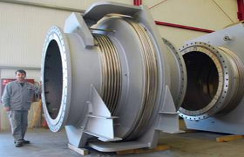
Bellows are manufactured by welding stamped, diaphragms into the long, flexible assembly. Strips of metal in sheet form are hydraulically stamped into the diaphragm shape. The pressure, stroke length, spring rate and temperature help to determine thickness and material required to meet the applications’ demands.
Ripples shape and inside and outside edges of the diaphragm are crucial to the performance of the bellows assembly. The ripples need consistency between diaphragms to survive high cycles and create accurate spring rates. The inside and outside diameters will be welded later in the process; with properly stamped edges, welds are leak-tight.
Once stamped, diaphragms are inspected for quality and cleaned. The cleaning preparation varies between Bellow Manufacturers, but the main focus is to ensure that the material is free of any grease or dirt to ensure the welds are strong and leak-tight. The diaphragms need special handling after the process as well to ensure that the natural oils of skin do not come into contact with the diaphragms.
The diaphragms are put back-to-back (male to female) to pair inside diameter holes. Once the inside diameters come into contact with each other, they are welded together. Depending on the Bellow Manufacturer and material, welding can be accomplished through plasma, laser, arc, beam welding equipment. Vision systems can aid the accuracy and consistency of welds. This process is continued in order to make the proper number of convolutions. The convolutions give the bellows assembly the flexibility and performance characteristics.
Once the inside diameter welds are completed, the convolutions can be prepared for outside diameter welding. Depending on the welding equipment, copper rings inserted between convolutions in order to ensure that the heat from these welds doesn’t distort material property in adjacent material.
End plates or flanges can be welded to the end of each side of the bellows assembly per customer requirements. Once completely assembled, bellows are helium tested to guarantee the assembly is sealed completely. The industry standard leak rate is 1×10-9 for stainless steel material, but lower leak rates are required for certain applications.
While a common question for bellows is, “what pressure can the bellows hold,” it is typically answered with a question or series of questions. The differential pressure between the inside (P1) and outside (P2) of the bellows is critical as well as if P1 or P2 is greater. Understanding the application details also help to design the bellows to ensure that the proper function and cycle life. Axial and lateral offsets can also change the pressure capabilities of the bellows assembly.
If you really wish to purchase the industry bellow then the best Engineer is the best option for you as it offers the best solution for protection of machine bellows, hydraulic as well as other mechanical rods & shafts. Different types of Industrial bellows are the best option to make your whole task quite simple than ever before. Hopefully, this web based article will help you lot to gather information related to Universal Bellows. Now, you may have enough information even about manufacture of the bellows.


Leave a Reply